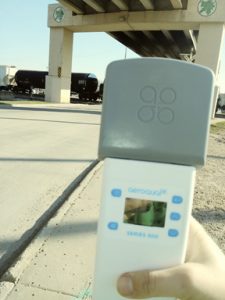Air Quality
The Long March To Environmental Justice Begins with First “Let Joppa Breathe Alliance” Meeting

Council Member Kevin Felder welcomes participants to the Let Joppa Breathe meeting at GoodWork last Monday night.
Approximately 20 representatives from advocacy groups, non-profits, and neighborhoods gathered last Monday evening at GoodWork for the very first meeting of the “Let Joppa Breathe Alliance.” It was the first step in organizing a city wide effort to reverse over a century of racist zoning and land use planning in Dallas’ oldest Freedman’s community.
Besides Downwinders, there were members of Joppa Freeman’s Township Assocition, the South Central Civic League, the Inclusive Communities Project, Paul Quinn College, the NAACP, North West Texas Legal Aid, and Mia Carmen Theater company. As impressive as the breadth of support was, it was also the first time in memory that whites constituted a tiny fraction of attendance at a citywide Dallas environmental strategy meeting.
Rage Almighty, the spoken word artist who MC’d the May 22nd Joppa benefit was back to facilitate. District 7 Council  Member Kevin Felder was also back to welcome participants and encourage the building of the broadest possible coalition to win victories.
Member Kevin Felder was also back to welcome participants and encourage the building of the broadest possible coalition to win victories.
On the agenda were updates from the community, including photographic evidence presented by JFTA’s Temeckia Derrough of continued dust and diesel pollution problems from the existing Martin Marietta batch plant operation. There are continuing rumors about the company coming back to request a second chance at permitting the two proposed batch plants that were denied by the city council in March.
There was also discussion about how the group can estimate the emissions from all the short-haul diesel locomotives going back and forth in the Union Pacific switch yard that runs the length of the entire community. Usually the engines that end up in a switch yard are already old and in need of maintenance – yard duty is seen a step away from retiring the locomotive. Their exhaust contains a very toxic form of PM called Carbon Black that’s more carcinogenic than your average PM pollution. Electrification of these locomotives would eliminate a significant source of PM pollution in Joppa.
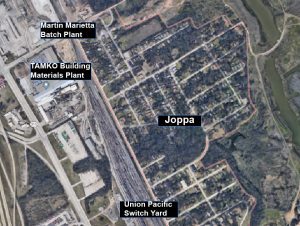 Misti O’Quinn with Downwinders reported that the group and UTD were very close to reaching a deal to place the first air monitor in Joppa, with a location to be announced soon. Another ten have been ordered and will probably be ready to be installed by November. The search is on for locations, with emphasis on getting front line readings close to batch plant, switch yard and the TAMKO shingles plant.
Misti O’Quinn with Downwinders reported that the group and UTD were very close to reaching a deal to place the first air monitor in Joppa, with a location to be announced soon. Another ten have been ordered and will probably be ready to be installed by November. The search is on for locations, with emphasis on getting front line readings close to batch plant, switch yard and the TAMKO shingles plant.
Plans are in the works to have a neighborhood enforcement workshop that includes the staff from City of Dallas Office of Environmental Quality, North West Texas Legal Aid attorneys and others advising residents how to be more effective in making complaints that can stick and lead to changes. Tentative scheduling has it penciled in for a date in later October or early November.
Participants scheduled the next Let Joppa Breathe Alliance meeting for 6 to 8 pm on Tuesday, October 23rd at GoodWork Co-Working space, 1808 S. Good Latimer. All groups are invited to send a representative. This isn’t just an environmental issue. It’s a civil rights issue. The more groups we represent, the faster we can get needed change.
The North Texas Clean Air Network Gets an Unanimous Vote in its First Dallas City Hall Test…But Staff is Still Resisting
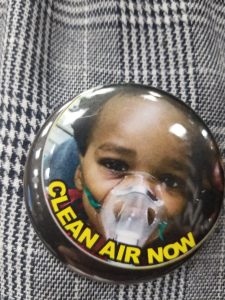 Rebuking its own staff’s misinformation campaign, the Dallas City Council’s seven-member Quality of Life Committee voted unanimously at its Monday morning meeting to recommend joining the North Texas Clean Air Network.
Rebuking its own staff’s misinformation campaign, the Dallas City Council’s seven-member Quality of Life Committee voted unanimously at its Monday morning meeting to recommend joining the North Texas Clean Air Network.
But in an unusual move, staff requested and received an almost three-month delay in scheduling a full city council vote on endorsing the new local air monitoring system. It won’t be until December 5th when the entire council gets briefed on the Network, and December 12th when they actually vote on whether to join. That’s a very long gestation period for a measure that just passed in Committee 7-0.
Staff claimed they wanted the long pause because of what they said were questions about how the city would participate in the Network and what provisions were necessary to get access to monitor locations like….utility poles. Citizens might be forgiven for suspecting the real reason for the three-month delay is to give staff time to find some new “fatal flaw” in the network and scuttle the whole thing before it ever comes up for a vote. If one listened hard enough, you could hear the startled disbelief in staff’s comments when the yes vote came down, despite every outward sign pointing to that outcome.
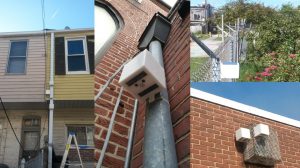 When one considers there was a Dallas city staffer at just about every meeting that led up to the creation of the Network, that these meetings began over a year ago, and that this specific presentation and vote has been scheduled for the Council’s review since August, it’s really quite incredible that staff admits they’ve spent no time thinking about how to implement this proposed policy within the city limits. Maybe because they’ve spent so much time trying to shoot it down.
When one considers there was a Dallas city staffer at just about every meeting that led up to the creation of the Network, that these meetings began over a year ago, and that this specific presentation and vote has been scheduled for the Council’s review since August, it’s really quite incredible that staff admits they’ve spent no time thinking about how to implement this proposed policy within the city limits. Maybe because they’ve spent so much time trying to shoot it down.
As late as the Friday before Monday’s vote staff was still at it, sending out a memo to Committee members downplaying the need for any regional network, conveying regulatory-correct but scientifically-misleading language about local Particulate Matter pollution levels, and writing one of the oddest sentences we’ve ever seen associated with air quality monitoring. In dismissing the formidable capabilities of the kind of low-cost high tech sensors the Clean Air Network will be using, Dallas Assistant City Manager Joey Zapata concluded, “These low-cost air sensors present new opportunities for uses beyond regulatory monitoring but are not yet able to provide direct measurements of real-time health impacts.“
That’s because that’s not what air pollution sensors or monitors do. None of them. Nada. Zero. Not even the really big and expensive ones the City currently operates for the State and EPA. They can only measure what levels of PM pollution are in the air you’re breathing, not what cancers, birth defects, strokes, heart attacks, diabetes problems, IQ loss, dementia or other illnesses that PM Pollution are causing “in real time” in your body as you breathe it in. No such Star-Trek-like technology exists.
In the real world researchers take the PM measurements recorded by sensors and correlate them to rates of illness. It’s a branch of science called epidemiology. The staff memo manages to completely confuse two wildly different scientific methods in a stunning, head-shaking way. It’d be flat-earth funny if it wasn’t, you know, the official position of Dallas City staff on the subject. Then it just becomes embarrassing.
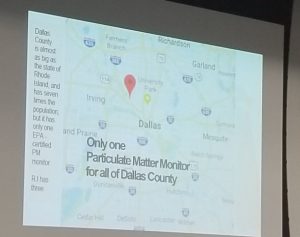 But whatever doubts about the Network staff tried to infect the council members with, they seemed to vanish once UTD Physics Professor Dr. David Lary and Downwinders’ Jim Schermbeck, representing the DFW Air Research Consortium, gave their 35-minute presentation on the Network.
But whatever doubts about the Network staff tried to infect the council members with, they seemed to vanish once UTD Physics Professor Dr. David Lary and Downwinders’ Jim Schermbeck, representing the DFW Air Research Consortium, gave their 35-minute presentation on the Network.
A roomful of “Clean Air Now” button-wearing supporters also helped the cause considerably. Thanks to everyone who came on an early Monday morning to make sure the Committee did the right thing. Thanks also to everyone who sent in emails to the Committee via our prepared Citizen Action website feature.
That combination of grassroots support plus technical expertise is one of the things that’s so impressive about this bottom-up approach, and it paid off again in the Committee meeting. Schermbeck made the case for change, Lary gave the details of how to build that change, monitor by monitor.
D Magazine published an online piece Monday morning that provides a point-by-point rationale for why this Network is A Big Idea Whose Time Has Come. Basically Big, Expensive and Slow has been replaced with Small, Cheap and Fast and it’s democratizing air quality information. All of that was included in the Committee presentation, plus examples of how it could have made a difference in the real world during a past crisis like the Sunshine Recycling Fire of December last year in West Dallas.
Both Plano and Dallas County officials have already said they’re onboard with the Network and may act to ratify the founding documents in their jurisdiction before the scheduled December Dallas vote. By the end of the year a new 21st Century regional air monitoring system, driven by local expertise, controlled by local governments, and designed to promote public health could become a reality.
But citizens may still have to fight to see it happen. In an ironic twist, the same staff that has been opposing the idea of Dallas joining the Network is now in charge of writing the briefing paper for the Council to explain why it’s a good idea. Bets are already being taken on how well they succeed.
ARC’s Network presentation was only half of an interesting compare and contrast exercise looking at two local projects using air sensors in two very different ways that Chair Sandy Greyson had arranged for the Committee.
The other half was a presentation by the Texas Nature Conservancy outlining their city staff-supported “resiliency” (i.e. Rockefeller) project, the “Breathe Easy” study proposing to place a PM and ozone monitor for two years at nine DISD schools that already see high student asthma and absenteeism rates, all below Interstate 30. Breathe Easy has already started spending money and needed no vote…although it was the first time any Council Committee had been briefed on it.
The study was supposed to get started back in August with the beginning of the school year but the nine schools haven’t been announced yet and so no monitors have been installed. Since the 2018-19 academic year is designed to provide a “baseline” of student asthma health, the study has already missed its chance of getting any data during the worst summer for ozone pollution in five years. It could take another month or longer to name the schools and wire-up the monitors. It’s uncertain how much this gap of missing information diminishes the value or definition of a baseline to which three specific intervention efforts are to be measured against beginning in the 2019-20 academic year.
Those intervention efforts include vehicle idling policies at or near schools, screens of vegetation between the 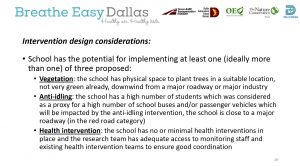 street and school, and in-school asthma therapies. The question being posed by the study is whether these intervention efforts have any impact on school-site pollution levels and therefore student asthma or absenteeism rates that can be measured.
street and school, and in-school asthma therapies. The question being posed by the study is whether these intervention efforts have any impact on school-site pollution levels and therefore student asthma or absenteeism rates that can be measured.
There’s certainly no harm in doing this study, but… its about ten years behind the times and spends a lot of money to tell us what we already know.
For example, we know DFW children’s asthma levels are higher than the national average. In their presentation, the TNC uses the 2009 Cook’s Children’s Hospital study made infamous by Downwinders almost a decade ago. That study contains the map showing a huge diagonal swath of childhood asthma running the length of Tarrant County that almost exactly syncs-up with the prevailing pollution plumes from the three Midlothian cement plants. Downwinders used that map time and again to prove the impact of the cement plants on downwind health during our Green Cement Campaign.
We know asthma is worse in minority communities. Many green groups were speaking out about this fact during the first wave of Environmental Justice activism during the 1990’s and have never stopped. What’s interesting is that TNC and the staff never ever talk about WHY this is a fact. It’s like they consider it an inherent genetic defect.
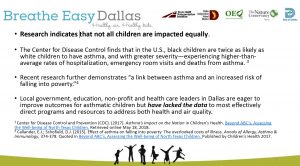 One reason might be that the Dallas City Hall staff now feigning concern for sick black kids is the same crew responsible for actively pressing racist zoning and land use planning in black and brown neighborhoods, like their predecessors before them.
One reason might be that the Dallas City Hall staff now feigning concern for sick black kids is the same crew responsible for actively pressing racist zoning and land use planning in black and brown neighborhoods, like their predecessors before them.
It was only last March when they were recommending approval for those two new batch plants in Joppa. Only last February when they recommended the Ash Grove Cement Silo in West Dallas. Before that they approved the move of the Argos batch plant from trendy Trinity Groves to a location next to a school in West Dallas.
Why do black kids have higher asthma rates in Dallas? Perhaps because the City of Dallas has designed it that way for over a century.
There is not a single note of contrition about this contradiction in the TNC or staff’s presentation on its Breathe Easy project. No “we’re sorry for putting people and polluters way too close in minority neighborhoods.” No “we’re going to do better from here on out – not just with these studies, but with actual policy.” No change in behavior, or even why there might need to be one, is ever discussed.
Those supporting the Breathe Easy study – or any other collaboration with the the Office of Environmental Quality and Rockefeller Sustainability – should understand they’re aligning themselves with a bureaucracy that’s been at the forefront of making the pollution problems in Joppa and West Dallas worse. And now the same bureaucracy wants to “study” the problem they helped make by testing out three piecemeal approaches to reducing exposure, rather than looking at how institutional changes could bring more fundamental and lasting solutions.
In the end, a year of intervention strategies at your school does little lasting good if you walk home through a polluted  neighborhood whose industries have been given a blank check by city staff.
neighborhood whose industries have been given a blank check by city staff.
We know reducing exposure to PM pollution improves your health. Lots and lots of studies show that.
We know which specific strategies work to reduce PM pollution. Buffer zones, vegetation screens, inside air filters, pollution controls, electrification of vehicles – all of these have been examined by researchers and found to reduce PM pollution levels. Even the Nature Conservancy cites the empirical success of tree planting in reducing pollution based on a past study. We don’t need a new study to tell us these strategies are effective. We need more money to implement them.
What the Breath Easy study seems to want to acquire is a new number – A, B and C intervention strategies reduce student asthma attacks/absenteeism by X, Y and Z amounts.
But can that be a meaningful, scientifically-robust number now that you only have an abbreviated baseline that excludes summer? Can it be meaningful if you only spend a year testing intervention strategies, including growing vegetation screens? Even applying copious amounts of Miracle Gro, your trees are not going to get that tall in 12 months.
Using all of TNC’s own data, a convincing case can be made that the $300,000 + being spent on this study could have been better spent on buying trees for those nine schools and installing them as PM screens. But that would have just reduced PM pollution. It wouldn’t have produced a study for the Rockefeller Foundation.
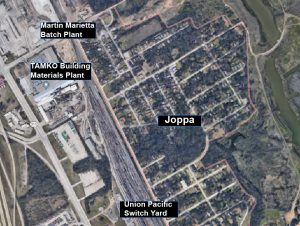 A dense regional Network of air monitors will begin to expose the deep disparities in pollution burdens in Dallas and elsewhere. It’ll provide a map to black and brown neighborhoods they don’t have now, providing further evidence that what you breathe in Dallas depends on where you live in Dallas. There’s plenty of indications this is the real disparity that Dallas City Hall staff are concerned with – even more than higher rates of black childhood asthma.
A dense regional Network of air monitors will begin to expose the deep disparities in pollution burdens in Dallas and elsewhere. It’ll provide a map to black and brown neighborhoods they don’t have now, providing further evidence that what you breathe in Dallas depends on where you live in Dallas. There’s plenty of indications this is the real disparity that Dallas City Hall staff are concerned with – even more than higher rates of black childhood asthma.
The curtains are about to part and provide a much clearer picture of how Dallas’ institutional racism has poisoned its own residents. It behooves everyone who calls themselves an environmentalist in Dallas in 2018 to commit to changing that picture, not just studying it.
New Study Finds PM in Placentas

Scientists already knew that maternal exposure to PM pollution had the potential to harm fetal development. Studies have documented higher rates of Autism, ADHD and other developmental diseases in close proximity of freeways and other large sources of PM pollution. But until now researches hadn’t actually identified how PM harmed newborns.
According to a study presented last week at the European Respiratory Society’s (ERS) international congress in Paris, researchers have found the first evidence that particles of air pollution travel through pregnant women’s lungs and lodge directly in their placentas.
Using an optical microscope, they examined the placentas of five non-smoking women who all delivered healthy babies. They found 72 dark particles among 3,500 cells and then used a powerful electron microscope to examine the shape of some of the particles. They looked like the sooty particles found in macrophages in the lung.
One of the study’s authors, Dr Lisa Miyashita of Queen Mary University of London, ruled out almost any other substance, “We can’t think of anything else they could be. It is very evident to us they are black sooty particles.” Dr Norrice Liu, also at Queen Mary University of London and part of the team stated, “We also know that the particles do not need to get into the baby’s body to have an adverse effect, because if they have an effect on the placenta, this will have a direct impact on the foetus.”
Almost every effort examining the health effects from PM pollution over the last decade have all concluded there’s no level of exposure that’s not capable of leaving some harm behind. What this new study indicates is that many of us may already be harmed by exposure even before we’re born and that may make additional exposure that much more harmful.
Just this past month two new reports were published that linked PM pollution to significant IQ loss and diabetes.
In separate research, also presented at the Paris congress, researchers found that children with early onset and persistent asthma fared far less well in education than those without the condition.
The study, conducted over 20 years in Sweden, showed that children with asthma were three and half times more likely to leave school at the age of 16 with only basic education and were also twice as likely to drop out of university courses
Take 60 Seconds and Urge Dallas City Council Members To Approve Joining A New Regional Air Monitoring Network
CLICK HERE
TO SEND A PREPARED EMAIL TO DALLAS CITY COUNCIL MEMBERS URGING DALLAS JOIN THE NEW NORTH TEXAS CLEAN AIR MONITORING NETWORK
Next Monday, September 24th, the Dallas City Council’s Quality of Life Committee will have a chance to take the City’s air quality tools into the 21st Century.
Committee members will view a presentation on the fledgling North Texas Clean Air Network and be asked to join Plano and Dallas County in signing-on to the state’s first independent air monitoring network. A yes vote will send the decision to the full City Council.
 There’s no mandatory fee to join. Every city, county or other governmental entity gives what it wants. This slow cook approach has already put 50-70 new high-tech-low-cost monitors in play from Plano to Joppa over the past year.
There’s no mandatory fee to join. Every city, county or other governmental entity gives what it wants. This slow cook approach has already put 50-70 new high-tech-low-cost monitors in play from Plano to Joppa over the past year.
Fueled by expertise at area research universities and constructed with the help of local officials and environmentalists, the Clean Air Network treats air quality monitoring as a public health tool to be run as a public utility.
Once in place, dense grids of real time Particulate Matter pollution monitors can have lots of benefits and uses. They can act as 24/7 fence line mon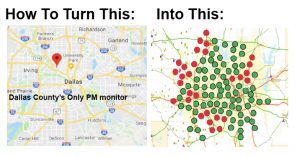 itoring for industrial facilities, help determine the right timing of traffic lights to reduce air pollution, map pollution disparities neighborhood by neighborhood, and correlate pollution burdens with public health. Because of its potential to inform and create policy, this air monitoring network represents one of the most significant environmental advances for DFW this century.
itoring for industrial facilities, help determine the right timing of traffic lights to reduce air pollution, map pollution disparities neighborhood by neighborhood, and correlate pollution burdens with public health. Because of its potential to inform and create policy, this air monitoring network represents one of the most significant environmental advances for DFW this century.
Please help make sure the Network clears this first political hurdle to full City Council approval. Send a quick “click and send” email to every member of the Dallas city council’s Quality of Life Committee members telling them you support Dallas joining the North Texas Clean Air Network. You can add your own message too.
Thanks.
MAY 22 FREE Citizen-Science Training for Portable Air Monitoring
SATURDAY, SEPT 22
Session 1:
10:30 am -1 pm
Session 2:
2pm to 5 pm
Goodwork Co-Working Space
1808 South Good Latimer/Dallas
For the first time, Downwinders is offering members of the public the chance to learn how to take air quality samples with one of our Aeroqual Series 500 portable Particulate Matter monitors – the monitors that helped defeat the proposed Joppa batch plants back in March.
For this first introductory lesson, there’s a 45-60 minute classroom presentation followed by 90 minutes in the field actually taking readings with the machines. The field trips will all be aimed at helping Downwinders assemble a growing data base on Dallas PM levels.
This customized training has been put together by Downwinders’ PM Science Director, Dr. Tate Barrett of UNT, as well as Cresanda Allen and Amanda Poland of our PM Committee. There’s no charge to attend. Lunch won’t be served, so bring some snacks and since we’re going out in the filed, you’re advised to wear comfortable shoes and clothes.
At the completion of this first hands-on training, participants will be given a  certificate that classifies them as “apprentice” level citizen scientists. This allows them to sign-up and go out on individual portable monitoring trips with members of the PM team in the weeks ahead. After two such outings with the team they’re classified as a Citizen Science “Researcher” and assigned more responsibilities.
certificate that classifies them as “apprentice” level citizen scientists. This allows them to sign-up and go out on individual portable monitoring trips with members of the PM team in the weeks ahead. After two such outings with the team they’re classified as a Citizen Science “Researcher” and assigned more responsibilities.
After three such excursions with team members, they’re classified as an “Investigator” and are eligible to check put the monitors for their own projects or help contribute to group efforts. In effect, we’re creating a lending library of portable air monitors open to anyone willing to go through the training.
On Saturday the 22nd we’re offering two training workshops:
Training Session #1 10:30am – 1pm
Training Session #2 2 pm – 5 pm
Both sessions will be conducted at the GoodWork Co-working space at 1808 South Good-Latimer, Downwinders’ home.
Participation is limited to let everyone get a chance to actually use the portables. To assure yourself a spot, please sign-up now by letting us know which session you want: downwindersatrisk@gmail.org, re:citizen science training.
New Study Links PM Pollution to IQ Loss
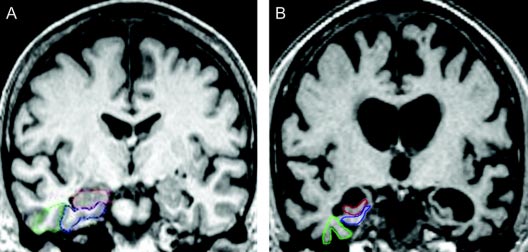
Underscoring how important this month’s event are is a new study from China that concludes exposure to Particulate Matter air pollution erodes a person’s IQ, especially in older people.
“Polluted air can cause everyone to reduce their level of education by one year, which is huge,” said Xi Chen at Yale School of Public Health in the US, a member of the research team. “But we know the effect is worse for the elderly, especially those over 64, and for men, and for those with low education. If we calculate [the loss] for those, it may be a few years of education.”
In some ways this latest research, published in Proceedings of the National Academy of Sciences (PNAS), only confirms earlier studies associating PM pollution with Dementia and other developmental diseases like Autism and ADHD. But it was the largest study yet to look at the impact PM has on cognitive abilities and it looked at people of all ages, not just students. 20,000 men and women were followed for four years and many other variables besides exposure to air pollution were ruled out as causes of the decline, including the inevitable decline of mental dexterity with age.
The more a person was exposed to dirty air, the more their intelligence suffered, with language skills suffering more than mathematical or analytical, and men more than women.
At the same time even short term exposure to air pollution was seen to have an effect on intelligence, a result with consequences for students taking tests or workers attempting to passing certification exams.
Derrick Ho from Hong Kong Polytechnic University was quoted in a Guardian article stating his own research group had similar preliminary findings in their work. “It’s because high air pollution can potentially be associated with oxidative stress, neuroinflammation, and neurodegeneration of humans.”
Specifically, exposures to pollutants such as carbon monoxide (CO) and particulate matter prevent proper blood flow and could affect the flow of oxygen to the brain, which in time, affect cognition. Long-term exposure of these pollutants can lead to lesions in the brain’s white matter, which is dangerous for cognitive skills.
The study has worrying implications for neighborhoods like Joppa and West Dallas that are crowded next to PM polluting industries and freeways. Residents from those communities often start out with material or social disadvantages that limit their opportunities. Constant exposure to a toxin that robs them of IQ points makes things even worse. It’s one more thing that can trap them in downward spiral.
POSTPONED! Dallas City Committee Meeting on Air Monitoring Rescheduled for September 24th
This coming Monday’s Dallas City Council Quality of Life Committee Meeting Concerning a New Air Monitoring Network is
POSTPONED UNTIL SEPTEMBER 24th.
Word came late Monday (yesterday the 20th) that City Budget resolutions tied to deadlines for budget submissions forced air monitoring off the agenda for the Committee’s August 27th meeting.
We’ve been assured that we’re DEFINITELY on the agenda for the Committee meeting scheduled for Monday, September 24th at 9am in Rm 6ES.
Although it’s a delay, it allows us more time to educate the council about the benefits of a public air monitoring network.
We apologize for any inconvenience.
Stay Tuned.
Fresh from the Vault: Open Records Act Results from the Dallas Office of Environmental Quality

Last month we requested the City of Dallas’ Office of Environmental Quality files concerning air quality monitoring going back a few years. We wanted to know more about how City staff chose the Texas Nature Conservancy’s “Breathe Easy” study as its first air monitoring project through a process of…well, there wasn’t exactly a process was there?
Here’s some highlights from the materials we reviewed so far:
Despite criticism, OEQ Staff is recommending using the same air monitors for its own study that Downwinders used in Joppa.
OEQ staffers have criticized Downwinders’ portable monitoring in Joppa…despite the lack of any city monitoring up to that point in the neighborhood. Something about the lack of reliable data. But lo and behold, OEQ staffers seems to have recommended not only the same company (New Zealand-based Aeroqual) to the Nature Conservancy for its stationary monitors, but also exactly the same portable air monitors. We told you they were good.
Any local university scientist who’s worked with Downwinders is blackballed.
Dr. Kuruvilla John, Professor and Chair Department of Mechanical and Energy Engineering at the University of North Texas was “…biased because funded by Downwinders” according to one meeting summary and blackballed by OEQ staff as a City technical advisor for the Breathe Easy project. Dr. John’s sole sin was to get paid as a contractor in 2015 by Downwinders to perform a single study using the state’s own computer model for DFW smog. Before ruling him out, no one on OEQ staff mentioned that Dr. John’s modeling and study was endorsed by a unanimous Dallas city council vote recommending the EPA take more proactive measures to reduce smog pollution.
One wonders if his collaboration with Downwinders and other citizens groups in the DFW Air Research Consortium have made UTD’s Dr. David Lary similarly verboten to OEQ staff.
Dallas City staff in-kind contributions to the Texas Nature Conservancy “Breath Easy” project are very, very large.
To date, the partnership between the City and the Texas Nature Conservancy has raised almost $300,000 in grant money for a study involving nine schools. But that total pales in comparison to the in-kind contributions the city is making to the effort over both its developmental period and it two-year run. For example…
Combine all the staff time over 3-4 years with data services costs and you could well have a multi-million dollar donation from the City of Dallas to the Texas Nature Conservancy, courtesy of your tax dollars.
OEQ staff likes the idea of a new air monitoring network…in other cities.
As one OEQ staffer put it: “We’re looking at air monitoring programs in states and cities. In Minneapolis/St. Paul the state agency is installing low cost (and low resolution) monitors in every zip code. In L.A. they are installing 100 monitors citywide. Baltimore, Chicago and Lafayette all have enhanced monitoring programs. Here the TCEQ has zero interest in any of these projects. The EPA staff are very interested, but cannot offer any financial support.”
A OEQ staffer sought a job with the Conservancy even as the Breathe Easy project was taking shape.
“We are teaming up with the Nature Conservancy and their new Urban Conservation Director ( a position I interviewed for in early 2017….)”
As you piece together the email chains and date memos, it’s clear that if it weren’t for the considerable support from the City of Dallas, the Nature Conservancy’s Breathe Easy air monitoring project would…need a lot more grant money.
Why has OEQ staff committed so much time and money to a two-year study of nine schools while dismissing the lesser expense and effort of joining a regional network of air monitors many times that size? A real time air quality network modeled on the very kind OEQ staff seem to admire from afar in other cities? That’s an answer that we haven’t found in the files yet.
But it’s something to keep in mind for the re-scheduled September 24th Quality of Life Committee meeting where presentations about both the TNC/City’s private study and the DFW Air Research Consortium public network will be featured.
PM Causes Diabetes: Another Study on the Dangers of PM Pollution
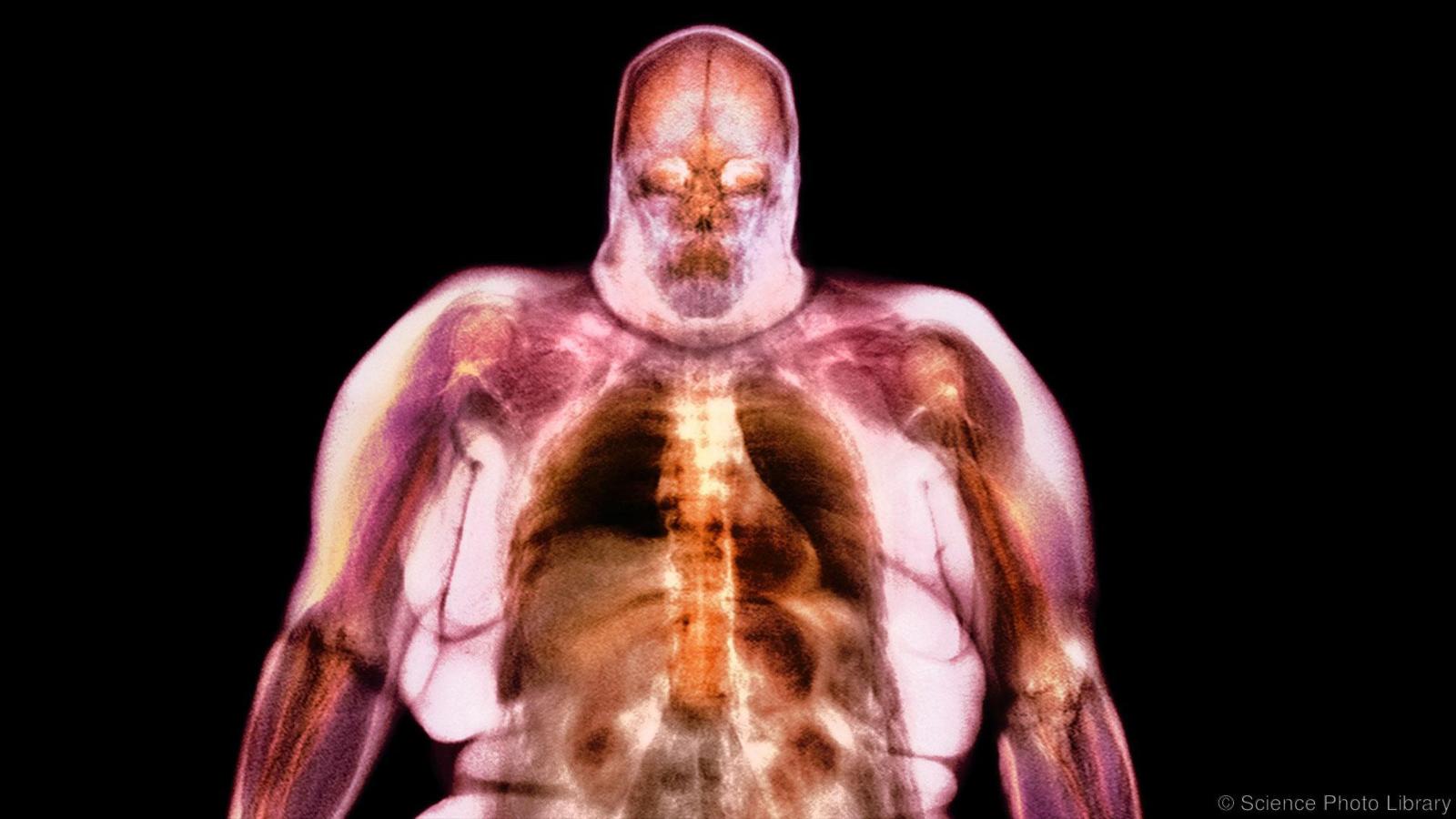
A new study published last month in The Lancet is the best evidence yet that besides causing and irritating asthma, heart attacks, strokes, dementia and autism, PM pollution can also trigger diabetes.
Using new statistical tools, it estimated that American air pollution caused 150,000 new cases of diabetes in 2016 alone. Worldwide, 8.2 million years of healthy life were lost to the disease by pollution.
Funded by the US Department of Veterans Affairs, and authored by VA doctors and others from the Saint Louis area, the study is the largest to ever examine the link between PM exposure and insulin resistance, the condition that often results in Type 2 diabetes in adults.
It used data from almost 2 million American veterans that were followed for eight and half years and matched with air quality data from NSA and EPA sources. The authors controlled for obesity and BMI, so it wasn’t the case that heavier people simply lived in more polluted neighborhoods and were also more likely to get diabetes. Rather, increased exposure to PM increased your likelihood of getting Type 2 diabetes.
There are many reasons why PM pollution is so harmful, but a big one is that it’s so very tiny and often contains toxic metals. Its small size allows it to not only penetrate deep into the lungs, but lo pass right through to the bloodstream. There, it circulates to different organs and causes inflammation. The inflammation increases insulin resistance. Eventually, this insulin resistance can become so severe the pancreas becomes unable to pump out enough insulin to compensate, and diabetes can set in.
Besides making the case for a link between PM pollution and diabetes, the study also confirms there appears to be no level of exposure to PM that isn’t capable of leaving a harmful mark. While EPA’s annual PM pollution threshold is 12 μg/m3, or micrograms per cubic meter of air, this VA study says the risk of diabetes starts as low as an 2.4 μg/m3 average per year That is, your risk of getting diabetes from air pollution begins at a level of exposure that’s almost 10 times less than the regulatory standard called “safe” by EPA.
In an Atlantic article reporting on the study, experts are quoted as saying the connection between PM2.5 and various health risks is now so clear that people should try to avoid large amounts of particulates, if they can.
“Live away from the major sources of emission. Don’t live right near the 405,” Dr Al-Aly, one of the authors stated, referring to the congested freeway in Los Angeles.
Tanya Alderete, who studies the connection between air pollution and disease at the University of Colorado at Boulder, says people should rethink biking and running in heavy traffic, “We shouldn’t be engaging in strenuous physical activity during rush hour or near major roadways,” she says.
The close association between PM pollution and Environmental Justice issues has been documented repeatedly, most recently by the EPA itself. African-Americans are more likely to be exposed to high levels of PM than other demographic groups. At the same time, African Americans are almost twice as likely to be diagnosed with diabetes as non-Hispanic whites. This is not a coincidence.
No other form of air pollution is linked to the wide variety of illness PM is now associated with in the scientific literature. The more it’s studied, the more PM becomes the most insidious form of air pollution we know about.
Dallas’ Office Of Environmental Quality: “You Can’t Handle the Truth” about Pollution

MONDAY, AUGUST 27th
9 AM
ROOM 6ES
DALLAS CITY HALL
CITY COUNCIL QUALITY OF LIFE COMMITTEE HEARING ON DALLAS JOINING A NEW REGIONAL AIR NETWORK
______________________________________________
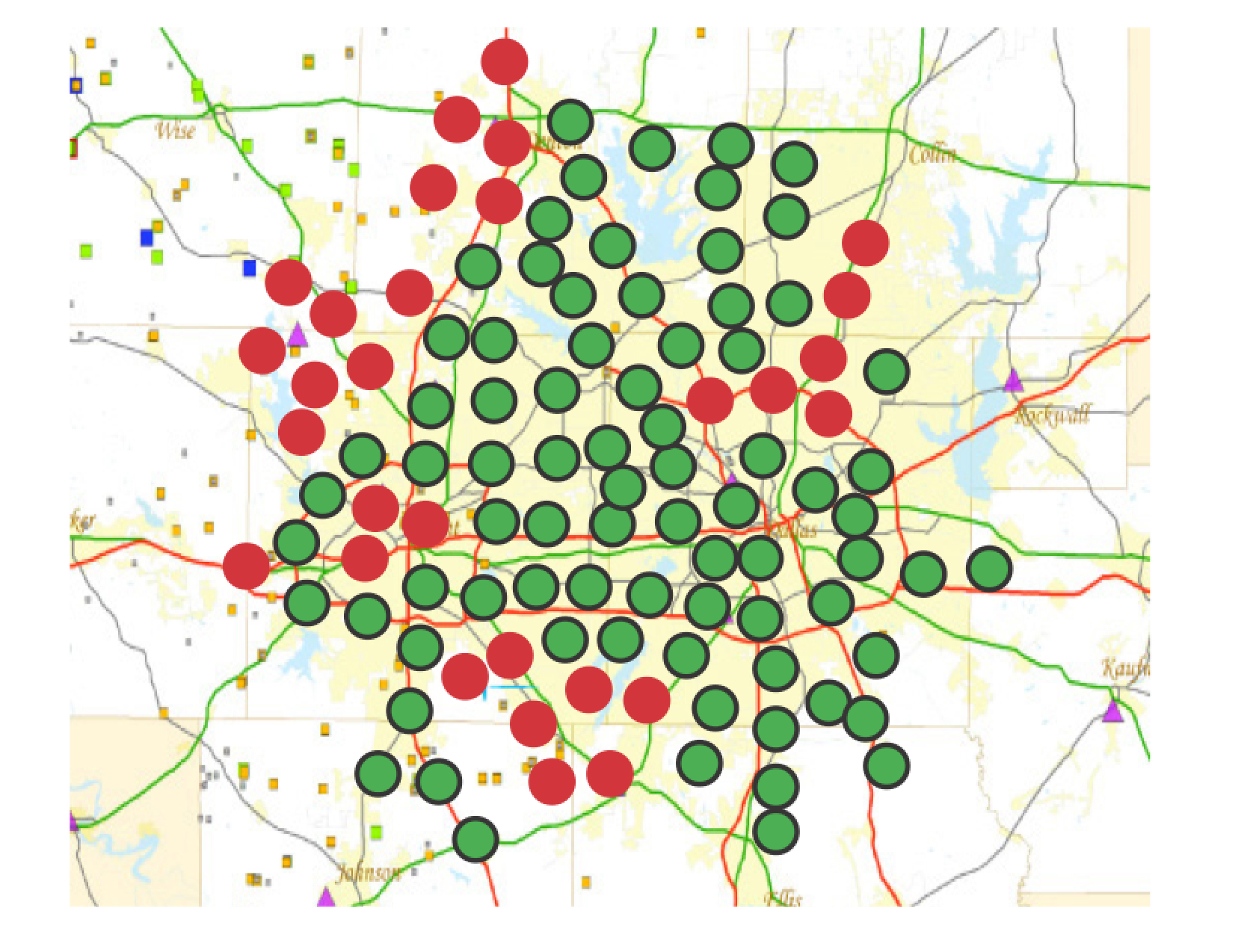 Over the last two years, as members of the DFW Air Research Consortium have promoted the idea of a dense grid of low-cost, high-tech air sensors spread across North Texas, their audiences have usually had one universal response: “This is great. It’s a no-brainer. When can we start? “
Over the last two years, as members of the DFW Air Research Consortium have promoted the idea of a dense grid of low-cost, high-tech air sensors spread across North Texas, their audiences have usually had one universal response: “This is great. It’s a no-brainer. When can we start? “
The single exception to this excitement is the City of Dallas Office of Environmental Quality.
Strange isn’t it? That hotbed of radical environmentalism known as Plano is embracing the idea of network air monitoring with both arms. Richardson and Fort Worth are interested as well.
But within Dallas City Hall there’s not only skepticism, but out right hostility to the the “smart city” idea of providing real time air quality information to citizens from hundreds of monitors.
Why?
On more than one occasion OEQ staff has said that they don’t want to have to take calls from Dallas residents who notice high air pollution levels in their neighborhoods and…expressed the opinion that “certain groups won’t responsibly use the information produced…like in Joppa.”
In other words, the public can’t handle the truth.
(Remind us again what happened in Joppa?

Oh yeah, Dallas OEQ staff was in favor of putting two additional dusty dirty batch plants in the small Freedman’s community that already has a large and polluting roofing shingles plant, a batch plant, and a huge rail switch yard surrounding it.
They made their recommendation for two more batch plants without doing any kind of air monitoring at all in Joppa, despite months of residents testifying at various hearings and meetings about the pollution problem and despite OEQ having the equipment to do it.
Staff made their recommendation without comparing the pollution in Joppa to other Dallas neighborhoods, or without examining any kinds of equity issues at all. Is Joppa the victim of Environmental Racism or not? The OEQ was silent.
Staff based their support solely on the lack of complaints – a record rendered invalid by plenty of Joppa community meetings where air pollution was complained about – and the moderate levels of pollution recorded by the single EPA-TCEQ PM monitor in all of Dallas County, located some nine miles away from Joppa near Mockingbird.
When Downwinders showed up a week before the Council vote and actually took air samples in Joppa for the first time, they showed levels of Particulate Matter that were much higher than that EPA monitor, demonstrating how ridiculous it was for OEQ to base its assurance to Joppa residents on it. It made them look like they hadn’t been doing their job. And they hadn’t. And they hadn’t done it in West Dallas with the concrete storage silo and batch plant fights there. Lately, OEQ hasn’t met a polluter it didn’t like.)
So instead of endorsing the idea that the public has as much of a Right-to-Know what’s in their air as in their food, OEQ would just rather you just not know. Ignorance is bliss.
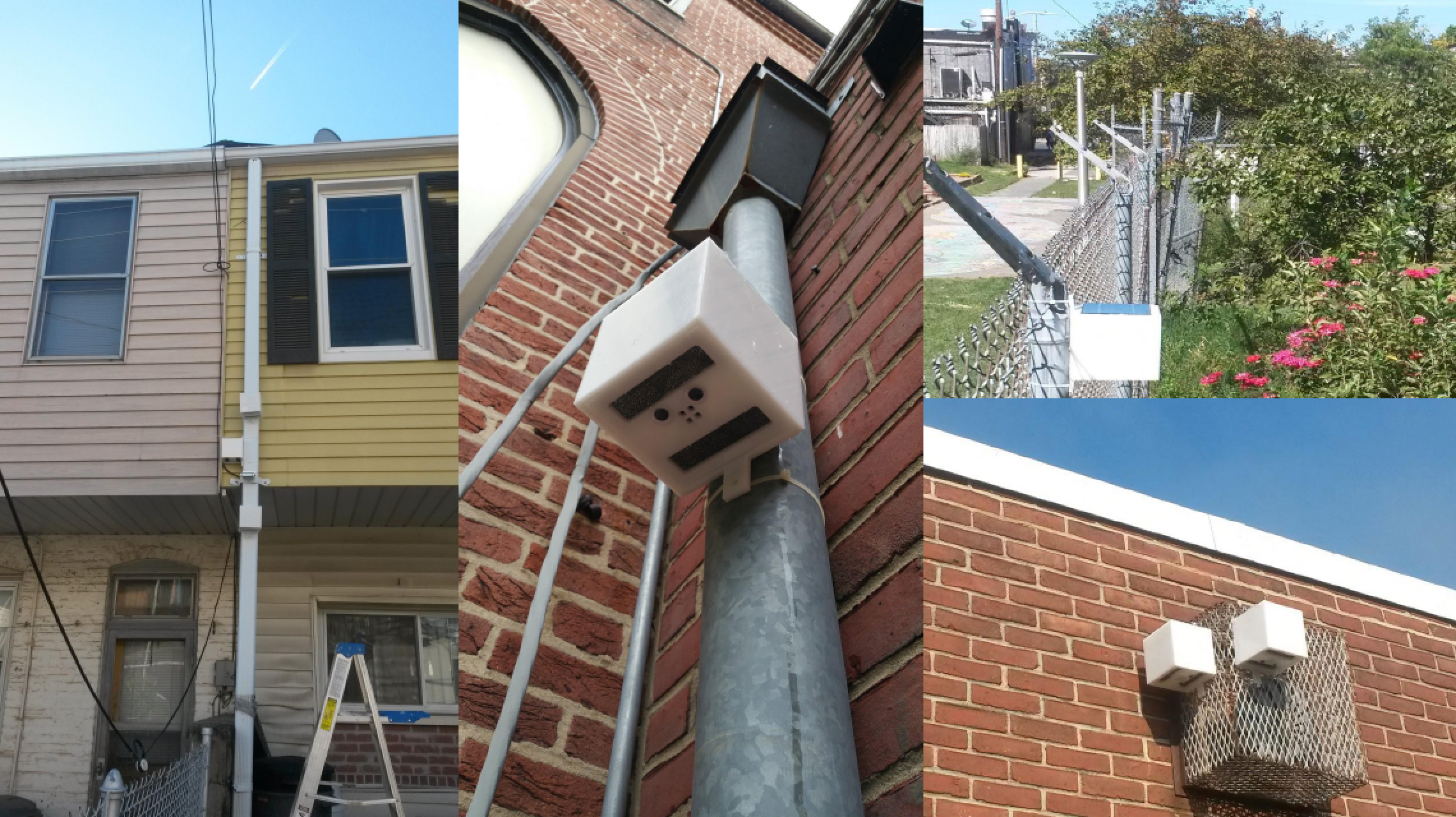 OEQ staffers also have said they object to a network of new air monitors because EPA doesn’t yet recognize their data as “official” and so it can’t be used for enforcement…yet. But do these air monitors have to have that official recognition to begin doing lots of good things for public health?
OEQ staffers also have said they object to a network of new air monitors because EPA doesn’t yet recognize their data as “official” and so it can’t be used for enforcement…yet. But do these air monitors have to have that official recognition to begin doing lots of good things for public health?
Joppa residents didn’t need EPA certification to compare the levels Downwinders recorded with the “official monitor” and know something was wrong. Doctors say they don’t need it to begin looking at correlations between area pollution levels and heart attacks, strokes ER visits, and school absenteeism. Cyclists and runners say they don’t need EPA certification to plot the least-polluted routes for exercising according to the grid. Cities like Plano says it doesn’t need it to better time traffic lights and reduce pollution that way.
It’s quite possible just knowing there are new monitors out there relaying real time information will now make a plant manager think twice about doing something questionable on a weekend or holiday. That’s enforcement – without EPA certification.
Given that Dallas currently doesn’t quantify or measure Environmental Justice issues in the city limits, a monitor network could provide planners and City Council members with a tool to do just that. It could graphically demonstrate how some Dallas neighborhoods are burdened with a lot more air polluters than others, and draw a map of those inequities to prevent them being made worse….to prevent mistakes like the OEQ staff was making in Joppa. You don’t need EPA certification for that impact either.

The hollowness of these staff arguments is proven by OEQ’s own actions. Even while it dismisses the unruly democracy of a real time broad-based PUBLIC monitor network, it’s committing over a million dollars of in-kind staff time and City resources to assisting a PRIVATE air monitoring study that is supposed to show how health can be improved….without EPA certification of the monitors being used.
So the same argument that city staff is using to dismiss the public network is the same one it’s using to support the private study.
You might recognize this M.O. at City Hall:
Staff decides it absolutely must do something about something. It decides how to accomplish that something after an exhaustive and rigorous search of talent and resources within a 100 foot radius of the office where that something is decided. An all out effort is then made to bias, slant, tilt, and otherwise favor the approach staff has decided must be taken against all other alternative approaches that might make sense outside of the 100-foot office radius. Nothing but the original staff approach is worthy of consideration, all others being the work of Satan or Dirty Hippies.
And the City Council? The Deciders for the public-at-large? They have an option to get involved at the very end of this sausage-making. Staff’s view seems to be that bliss is ignorance here too.
This happened with the Trinity River. Now it’s happening with air quality.
In 2014 Dallas got some Rockefeller Foundation money for “Resilience“ preparation. For those without a program, resilience is the fancy Rockefeller Foundation word for Climate Change, or rather the symptoms of climate change. Elected officials and bureaucrats are supposed to feel safer about using it.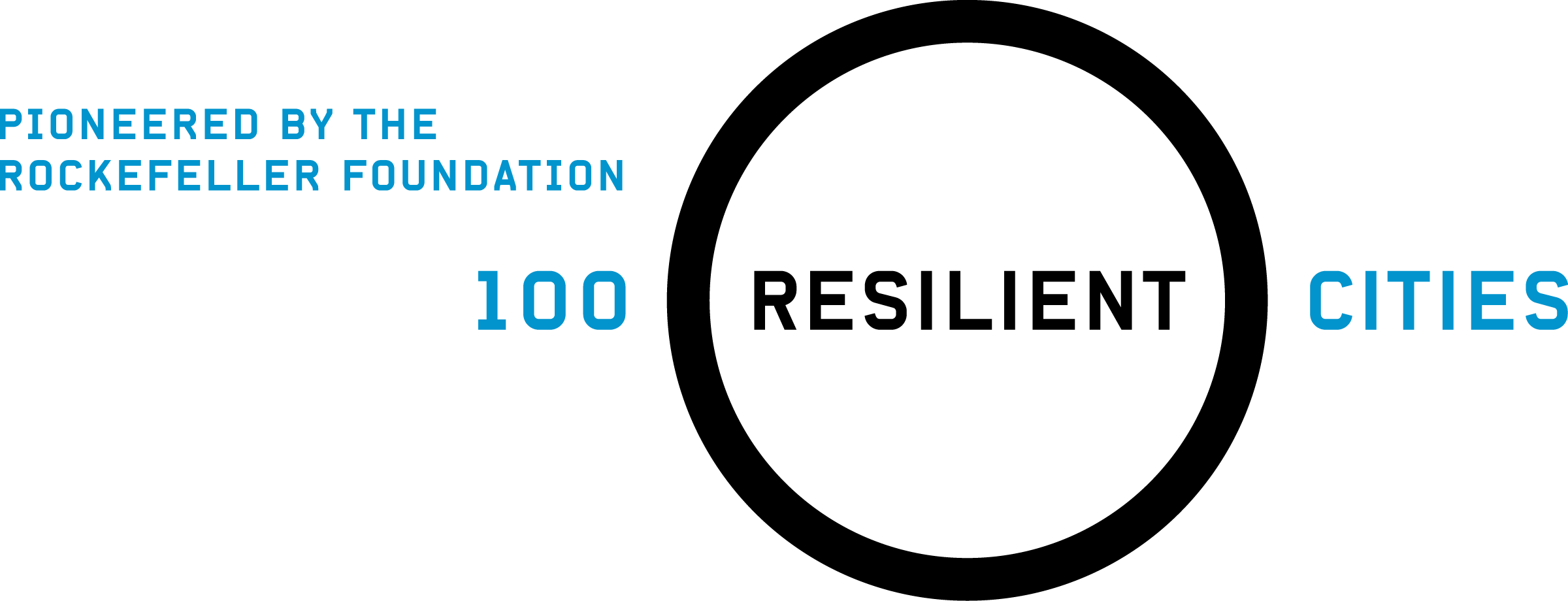
Dallas got so much money that the City created an Office of Resiliency. And that office sponsored invitation-only forums on how Dallas could be more resilient. Not open forums mind you. Not public hearings. They wanted the folks they’d located through that rigorous and exhaustive vetting process. None of the Satanists or Dirty Hippies got notice.
One of the right kind of groups that did get invited to those forums was the Texas Nature Conservancy, a mostly wealthy and white group of landowners dedicated to the noble idea of putting aside large tracts of undeveloped land for permanent preservation. It’s a group well-known for its dedication to open spaces – but not for any research it’s ever done on air quality.
Nevertheless, out of these forums suddenly emerged a partnership between the City of Dallas and The Nature Conservancy to do some kind of new air quality monitoring. There was no competition of concepts and no decision by the City Council. Staff had decided, and that was that.
And so you get the “Breathe Easy” Study.
Nine (as yet unspecified) DISD schools in “South Dallas” will be wired with new air monitors recording Ozone and Particulate Matter pollution in real time over one or two years to study the impact of anti-pollution measures like stricter idling policies on school absenteeism rates.
 But while the information will be gathered in real time from these nine schools, that information will not be shared with the public on the City of Dallas website until after (an as yet unspecified) time has passed. No annoying calls from pesky citizens (or parents) asking why their neighborhood’s air pollution levels are so high today.
But while the information will be gathered in real time from these nine schools, that information will not be shared with the public on the City of Dallas website until after (an as yet unspecified) time has passed. No annoying calls from pesky citizens (or parents) asking why their neighborhood’s air pollution levels are so high today.
Furthermore, after the study is completed it’s unclear what’s going to happen to the monitors in the nine schools.
In this case, the Conservancy and City seem to be tracking the “resiliency” of Dallas students in the face of chronic and acute air pollution problems, and then letting them know after the fact how resilient they were.
And is it irony, cynicism, or both when Dallas City Hall says this new study is needed because “Black kids in Dallas have an asthma rate eight times higher than Asian children and four times higher than whites.”
Maybe that’s because the Dallas OEQ keeps approving batch plants in their neighborhoods.
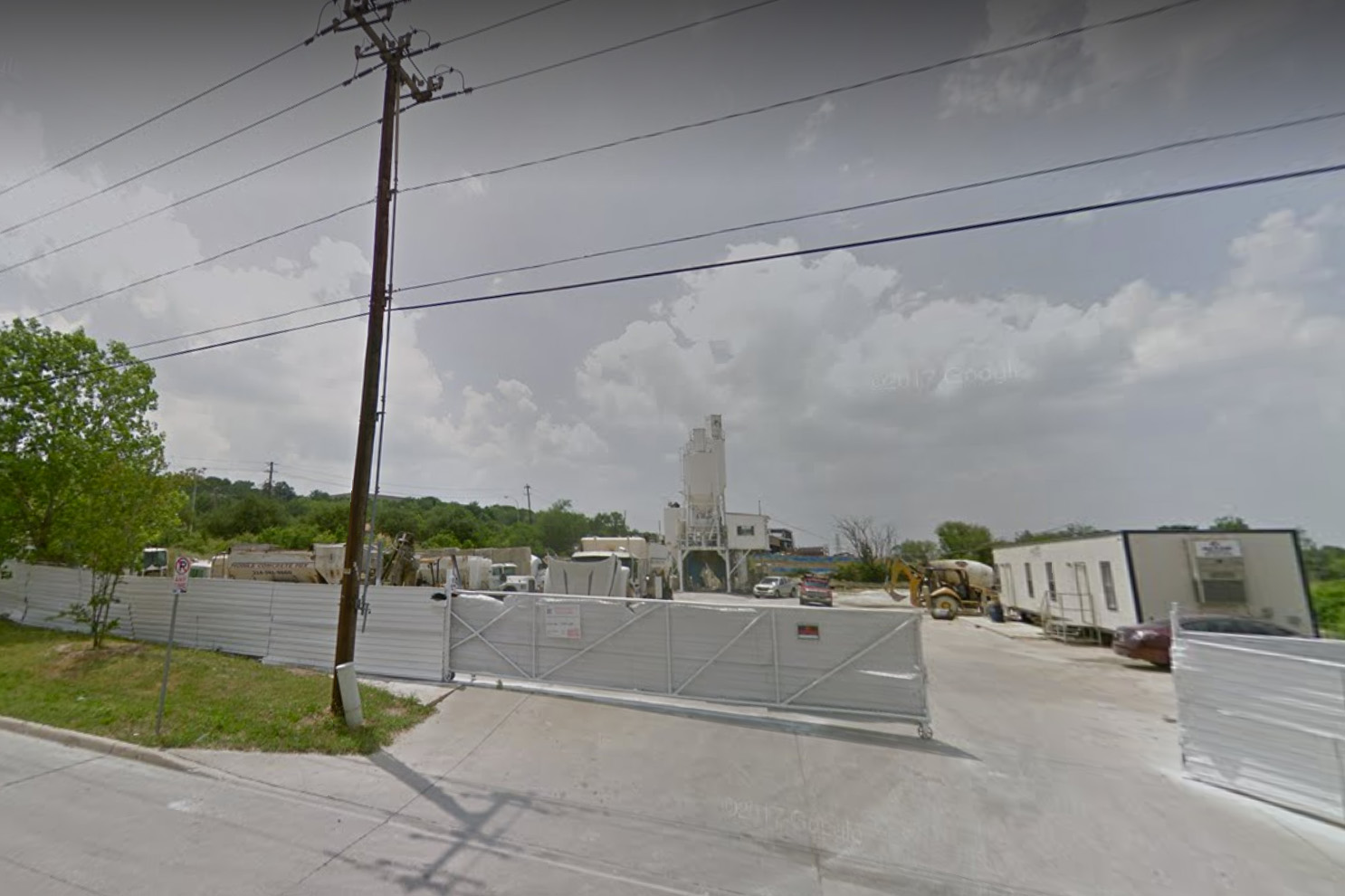 The same department which approved the relocation of the Argos batch plant from gentrified Trinity Groves to working class West Dallas, approved Buzzi’s 165-foot tall concrete silo next door, approved the RamCrete batch plant permit down the street, and whole-heartedly approved two new batch plant permits in Joppa IS NOW concerned about Environmental Justice issues! What amazing powers that Rockefeller money has.
The same department which approved the relocation of the Argos batch plant from gentrified Trinity Groves to working class West Dallas, approved Buzzi’s 165-foot tall concrete silo next door, approved the RamCrete batch plant permit down the street, and whole-heartedly approved two new batch plant permits in Joppa IS NOW concerned about Environmental Justice issues! What amazing powers that Rockefeller money has.
So far, TNC reports they’ve received almost $280,000 in grant money for support of this study. Paperwork found as part of a Texas Open Records Act Request Downwinders submitted to City Hall suggest the City is donating a million dollars in data services capacity alone. That’s in addition to the considerable staff time also lent to the effort. In-kind donations from DISD have not been disclosed.
We know that reducing kids’ exposure to PM pollution will help their health and well-being. We know one way to do that is by turning off vehicle exhaust. It’s not clear what kind of return the TNC or City is getting for its considerable investment.
Meanwhile, the idea of a new network of low-cost, high-tech monitors throughout North Texas giving the public real time information about the state of the air its breathing actually sounds like a great Rockefeller resiliency grant because it helps individuals and localities deal with the symptoms of climate change in their daily lives.
Moreover it’s an indigenous, grassroots effort.
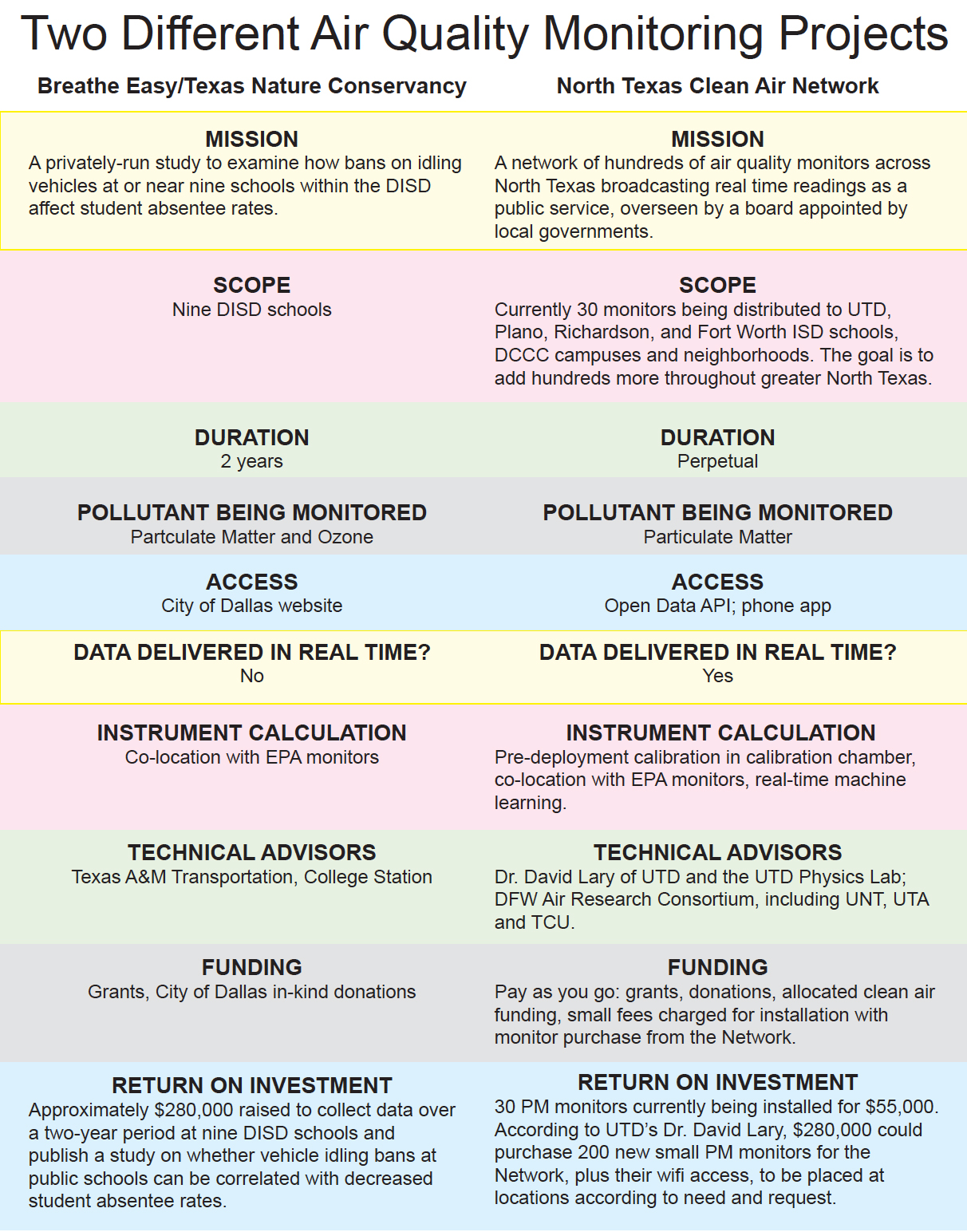
Because the rigorous and exhaustive vetting at City Hall didn’t make it the long 17 miles up to UTD, staff had no idea that one of the nation’s premiere experts in air monitoring teaches there. Oxford-trained Dr. David Lary just got a huge contract from the U.S. armed forces to help them better equip our soldiers for fighting in hostile and toxic urban environments. A big selling point was all the different air toxins in DFW standing in for the real thing. Honest.
It was Dr. Lary’s 2016 National Science Foundation proposal for a pilot project that got the regional network ball rolling. Even though it didn’t get funded, it brought together local governments, scientists, and citizens groups who then forged their own regional slow-cook version. Representatives from UNT, UTA, TCU, and UNT’s Health Science Center participated. So did Plano, and Dallas County.
Dr. Lary has outlined a monitoring network that’s capable of correcting itself in real time using those EPA official monitors as a baseline. EPA has said they’re interested in using his approach. So has NASA. He’s the foremost authority on this topic within hundreds and hundreds of miles but somehow, but Dallas city staff never found him because he wasn’t on that exclusive invite list.
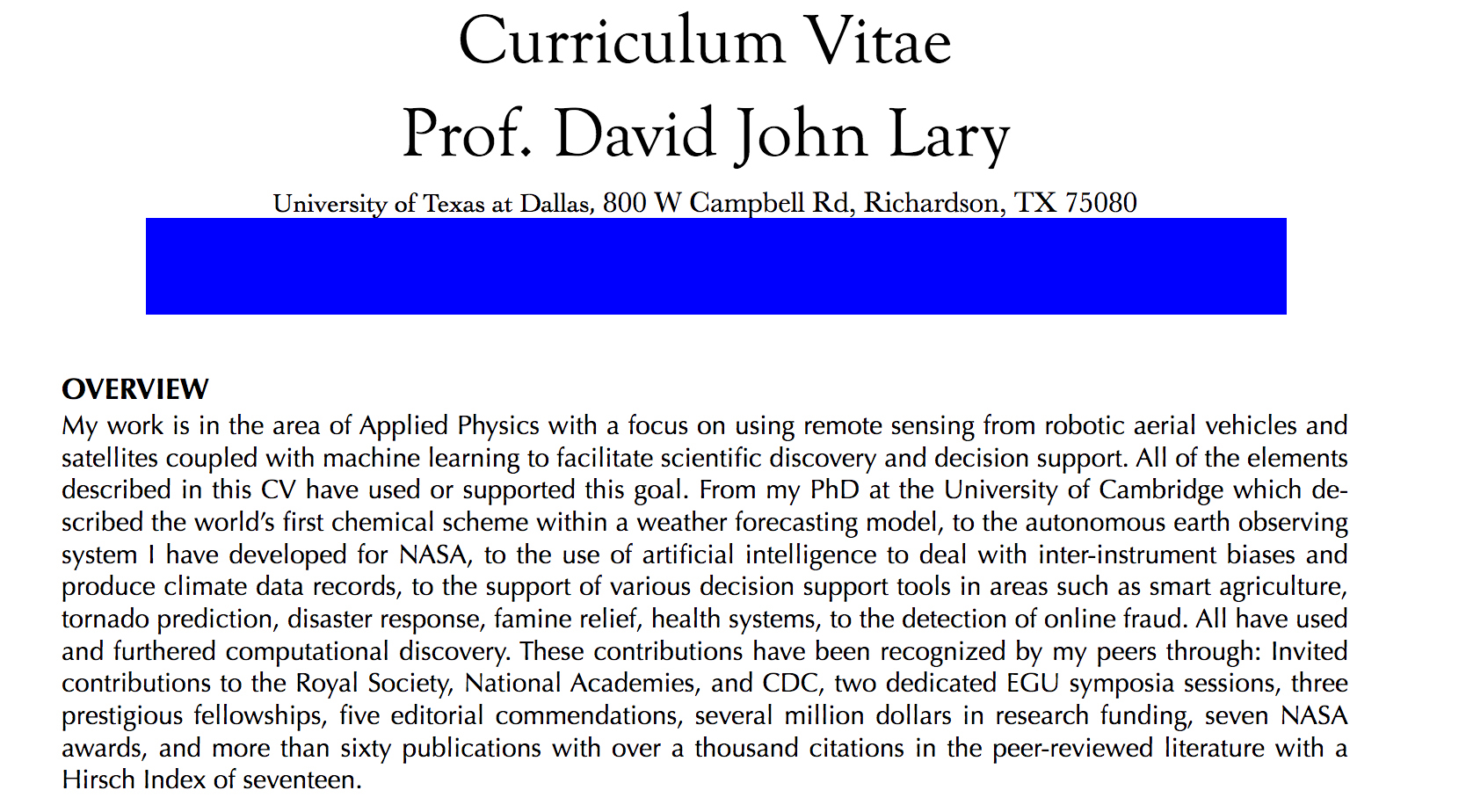 The TNC-Dallas Breathe Easy study is using the Texas A&M Transportation Institute for their air monitoring expertise. Much like the Nature Conservancy, this is a fine outfit, well-known for its work in transportation policy. It is not known for any air quality monitoring work and one can look in vain on its website for a mention of such. No one on their faculty even comes close to matching Dr. Lary’s credentials.
The TNC-Dallas Breathe Easy study is using the Texas A&M Transportation Institute for their air monitoring expertise. Much like the Nature Conservancy, this is a fine outfit, well-known for its work in transportation policy. It is not known for any air quality monitoring work and one can look in vain on its website for a mention of such. No one on their faculty even comes close to matching Dr. Lary’s credentials.
The kicker is that for the same $280,000 as Breathe Easy has raised, Dr. Lary has said he and his lab could build 200 + monitors for regional distribution. Data services will be donated by UTD. You get about 190 more monitors and real time public access for the same money.
So on the one hand you have an expensive study run by a private foundation for a short time using untested expertise, and on the other you have a cost-effective perpetual public network advised by one of the country’s leading authorities on air monitoring. You don’t have to have lived in Dallas very long to know which choice was the “no-brainer” for staff.
The Private Study and the Public Network don’t have to be mutually exclusive, but that’s the way City staff often portrays the choices to the Council – whose first exposure to any of this material will be at the scheduled August 27th Quality of Life Committee public hearing on joining the Regional Network, chaired by Council Member Sandy Greyson.
The Conservancy study could be done parallel to the establishment of the network and its school monitors folded into it at the end of the planned two-year shelf life. The city could help the Conservancy and be a part of the Network at the same time. But Staff seems to have made up their minds they can only support one air monitoring project, or rather, dug in their heels over the overly-democratic goals of this network project – it being supported by the Satanists and Dirty Hippies and all.
There’s no doubt that the same changes in technology which have disrupted other industries are disrupting environmental monitoring too. The ability to buy very reliable monitors for not much money is sending control away from top-down hierarchies to the bottom-up, crowd-sourcing rabble. A few expensive sites are being replaced by hundreds of inexpensive ones. Homeowners are already buying and installing their own consumer versions and linking to national and international networks. They’re making the status quo obsolete, one monitor at a time.
The regional network proposed by Dr. Lary and the DFW Air Research Consortium is designed to try to harness this disruption for public health’s sake. It’s open source, accepting all comers that meet its technical guidelines for participation, utilizes machine learning, and dispenses monitors where the science and need lead, no matter how many. It’s the same thing being done in Los Angeles, Baltimore, Chicago, and Chattanooga. And even Plano, which has already ordered its first monitors from UTD.
Plano has decided it wants a seat at the table as the sensor networks of the future are built. It’s participating out of self-interest because it knows otherwise, the city might not have a say in how the technology is used there. It’s the polar opposite from the sentiments Dallas OEQ staffers have expressed.
On the 27th, Council Member Greyson will be using her Committee hearing to contrast and compare the two air monitoring projects.
City staff will do one presentation on the Breathe Easy study and UTD’s Dr. Lary and Downwinders Director Jim Schermbeck will do another on the regional monitor network. 
Then it will up to the Committee to decide if Dallas can be as progressive on air quality as Plano.
We’re told there will be no public comment allowed. Still, we encourage you to come down to City Hall, put on a button, buy some popcorn, and root for Democracy. The Dirty Hippies are on a roll of late.


